Aenetus virescens (syn. Hepialus virescens)
by Laurie Meadows
Avocado
Puriri moth caterpillars (larvae) ring barked avocado branches for the first time in 2011/2012. The moth is a New Zealand native, and attacks native trees, mainly puriri and putaputaweta, and a range of introduced trees. The first hint was a wilting branch....
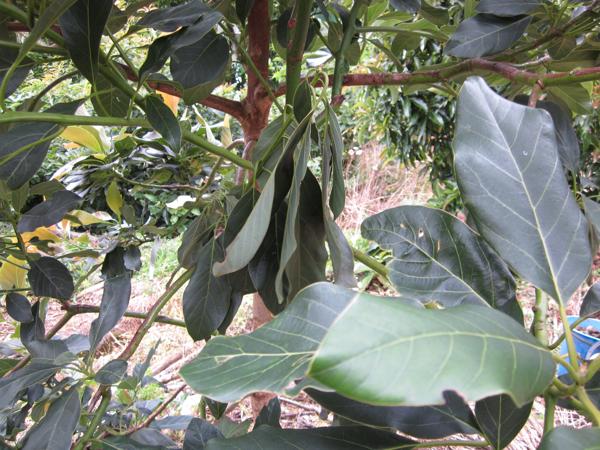
The point of entry was just above a small branch that had died back following a failed graft attempt...

The larva chews a channel right around the branch, effectively ringbarking it. And when an avocado tree exudes sap, the unique avocado sugars crystallise into a dusty pure white powder around the damaged area.
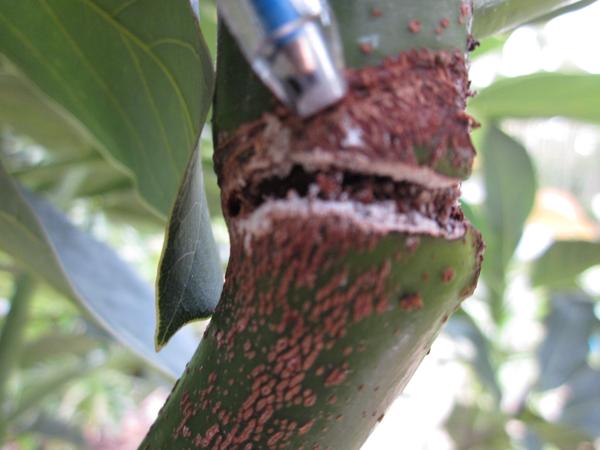
The groove is covered with webbing, and originates from a hiding hole the grub has chewed into the trunk.The Puriri moth caterpillar chews out the bark around the entrance to its hole, making a depression where the bark has been removed.
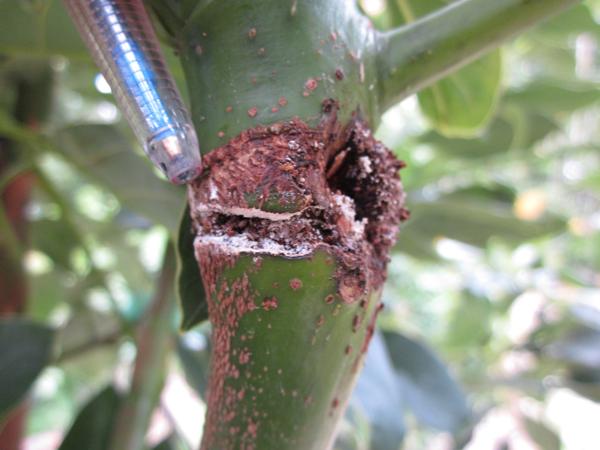

The tree tries to heal the damage with callus tissue, and it is the callus tissue that the Puriri moth caterpillar feeds on. It covers the depressed area with webbing, and sticks bits of bark onto the webbing effectively camouflaging its hiding place.
The give-away is the area of moist poo ('frass') at the bottom of the webbing.

The Puriri caterpillar chews the hole more or less vertically down the branch - but unlike the lemon tree borer, it does not keep going deeper and deeper, and there are no little frass ejection holes at intervals down the branch....
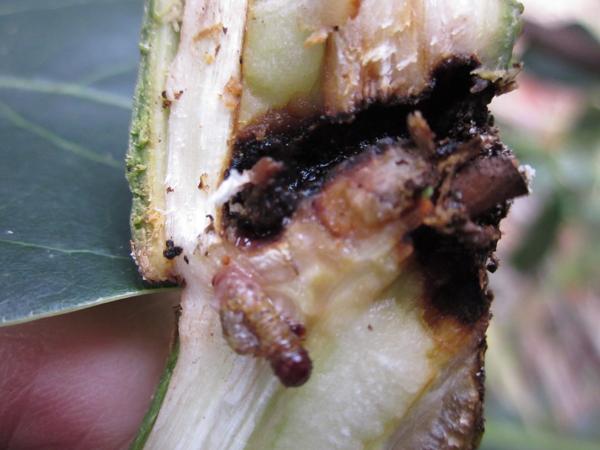
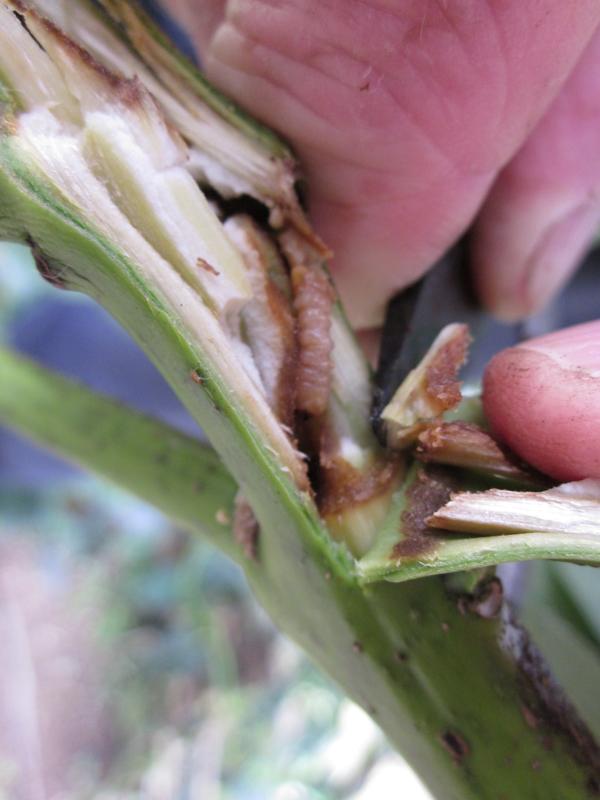
The whitey - colored larvae can seriously weaken smaller limbs. Their body shape and color is very similar to lemon tree borer larvae, but lemon tree borer is a beetle, and this pest is a moth caterpillar. The caterpillar has 6 true legs just behind the brown head, and several stumpy 'prolegs' at the rear.
Apparently the first stage of the Puriri caterpillars life is spent eating fungus growing on dead wood on the forest floor. I try to keep bits of rotting wood under my little avocado trees as part of the battle against Phytopthora root rot fungus, so the caterpillars have an ideal food supply.
So far, I have spotted 4 Puriri caterpillar holes in my young trees. The caterpillar seems to start its entry attempts at the point where a youngish branch joins either a main limb or the tree trunk, usually on the upper side of the join.
When the caterpillar starts a fair way out on a limb, all it will do is kill the branch above its hole. But where it drills into the young tree trunk and ring barks it, the entire top the the tree trunk will either die or snap off in a wind.
This is probably not critical if you grow avocados in the conventional way as a multi truck tree, but if you are growing them as a single trunk, you may end up with the entire top half of your tree snapped off.
If
you live near bush and have small avocado trees, it pays to look
for small areas of frass, and the white sugar deposits from
damaged tissue. Probe the hole under the web full of frass with
a fine wire to locate the hole, then spear the larva in its
hiding place.
Holm
Oak (bellota Oak, Evergreen Oak etc)
We have a few Quercus ilex ssp bellota seedlings planted in the hope of one day harvesting the edible acorns. Most of the half dozen or so trees have been unwitting hosts to larvae of the Puriri moth. I only discovered the damage recently when pruning the trees, as the moth leaves a thin 'skin' of bark over its workings, and the frass resembles the bark somewhat. I found two trees with empty pupal cases just protruding from the holes. Given the 'tree stage' of these caterpillars live for an average of about 2 years before they pupate and turn into moths, the larvae have had plenty of time to do damage.
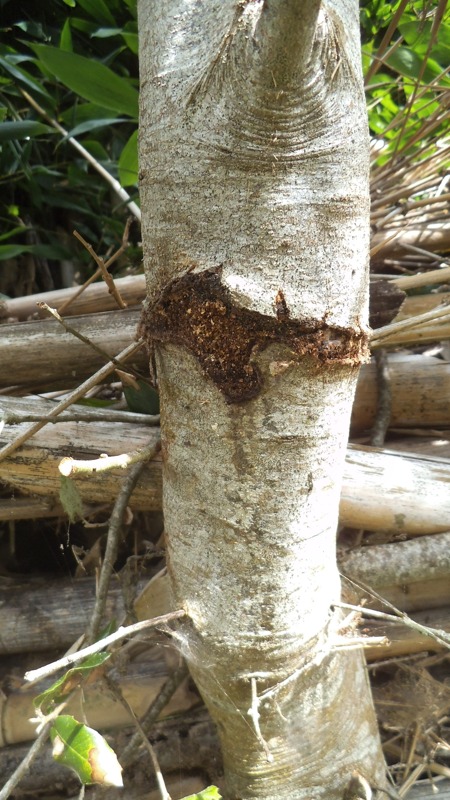

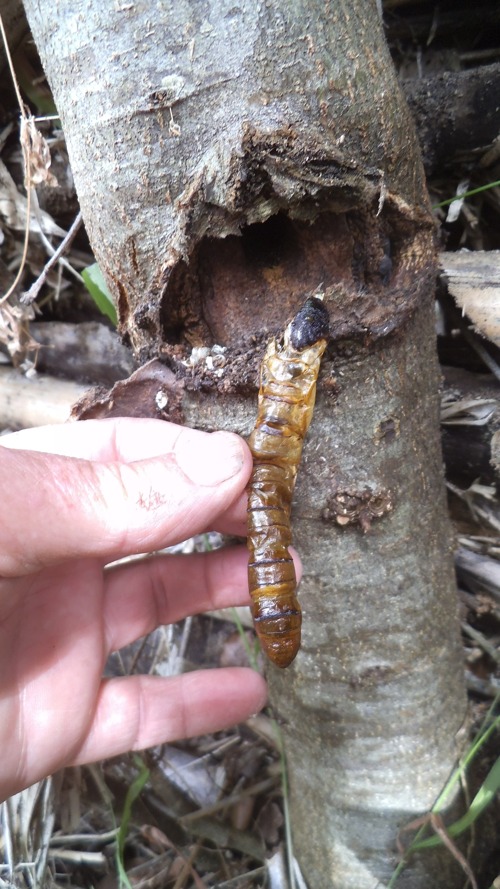
Frass obscuring the tunneling... Pupal case and the damage done - the thin bark cover pulled back... Empty pupal case showing the size of the caterpillar...!
We have a few Quercus ilex ssp bellota seedlings planted in the hope of one day harvesting the edible acorns. Most of the half dozen or so trees have been unwitting hosts to larvae of the Puriri moth. I only discovered the damage recently when pruning the trees, as the moth leaves a thin 'skin' of bark over its workings, and the frass resembles the bark somewhat. I found two trees with empty pupal cases just protruding from the holes. Given the 'tree stage' of these caterpillars live for an average of about 2 years before they pupate and turn into moths, the larvae have had plenty of time to do damage.



Frass obscuring the tunneling... Pupal case and the damage done - the thin bark cover pulled back... Empty pupal case showing the size of the caterpillar...!